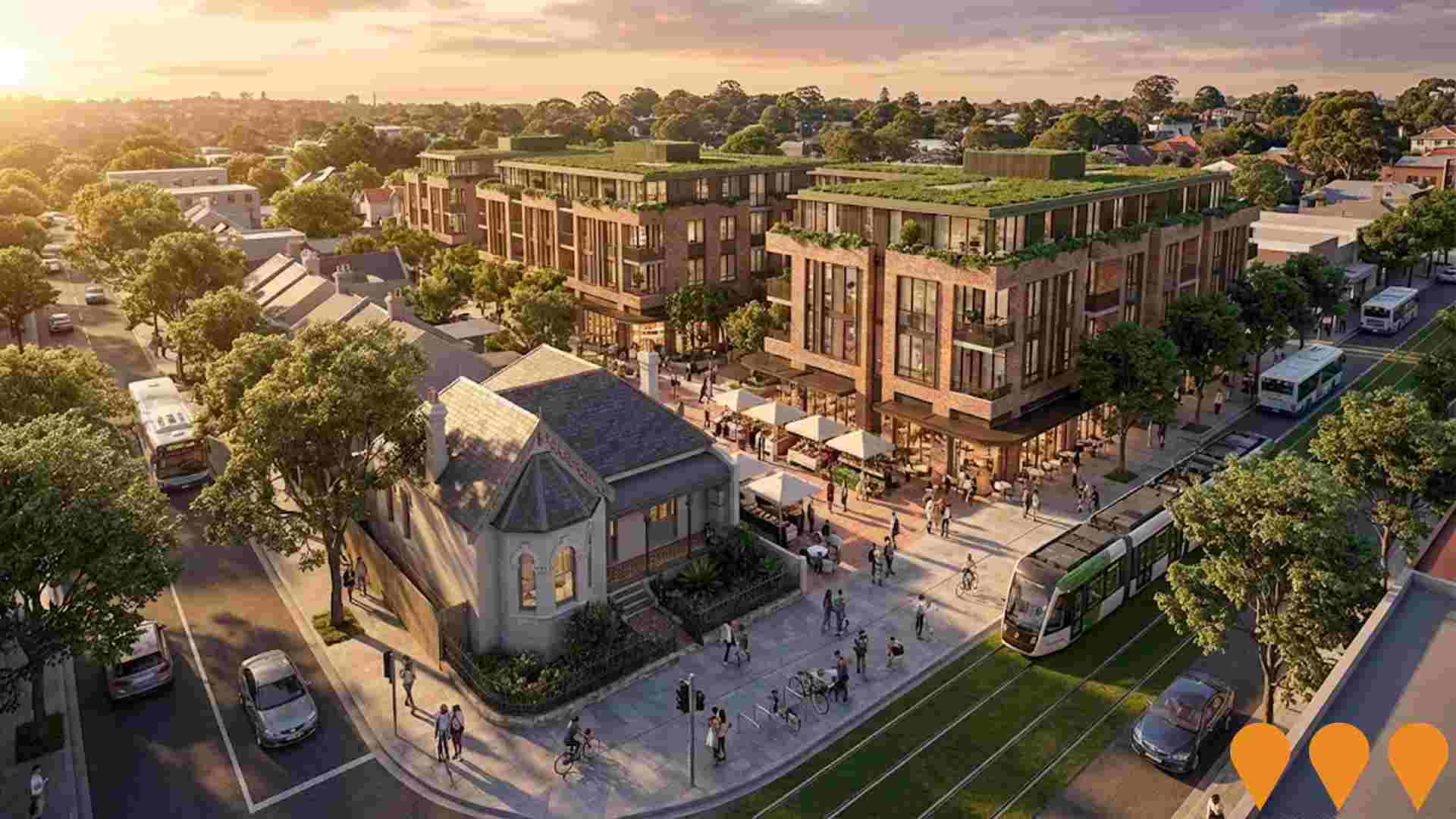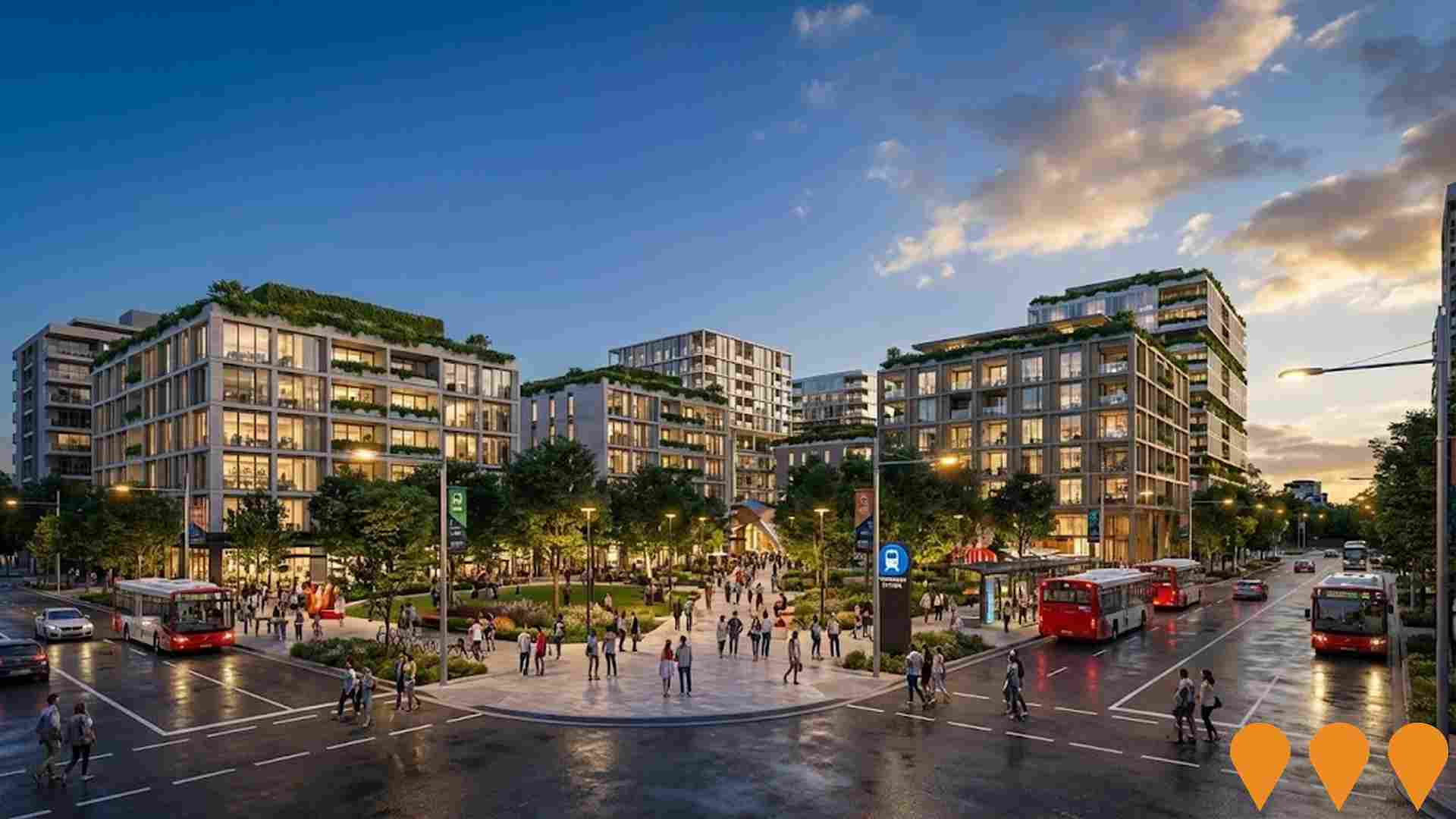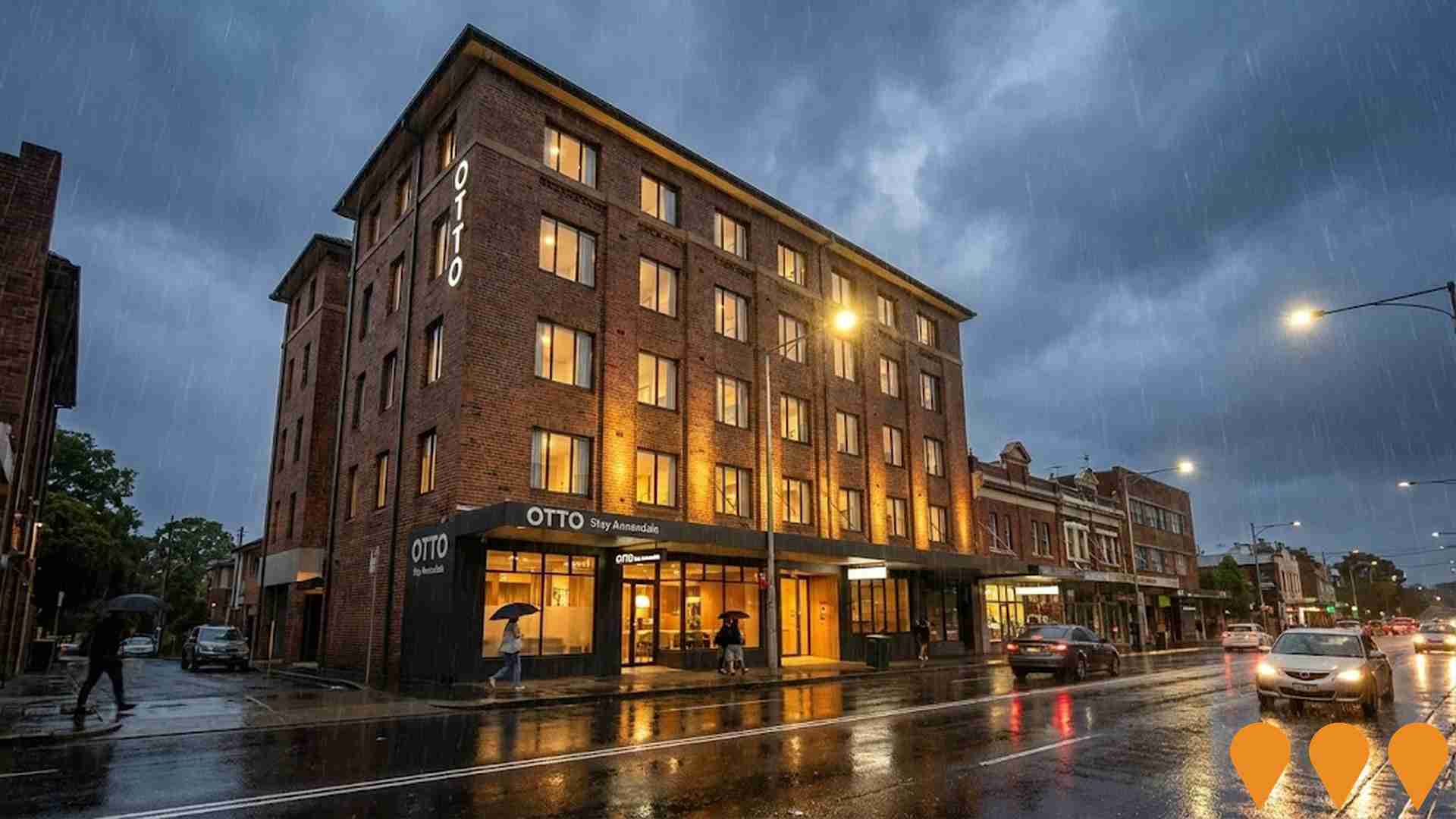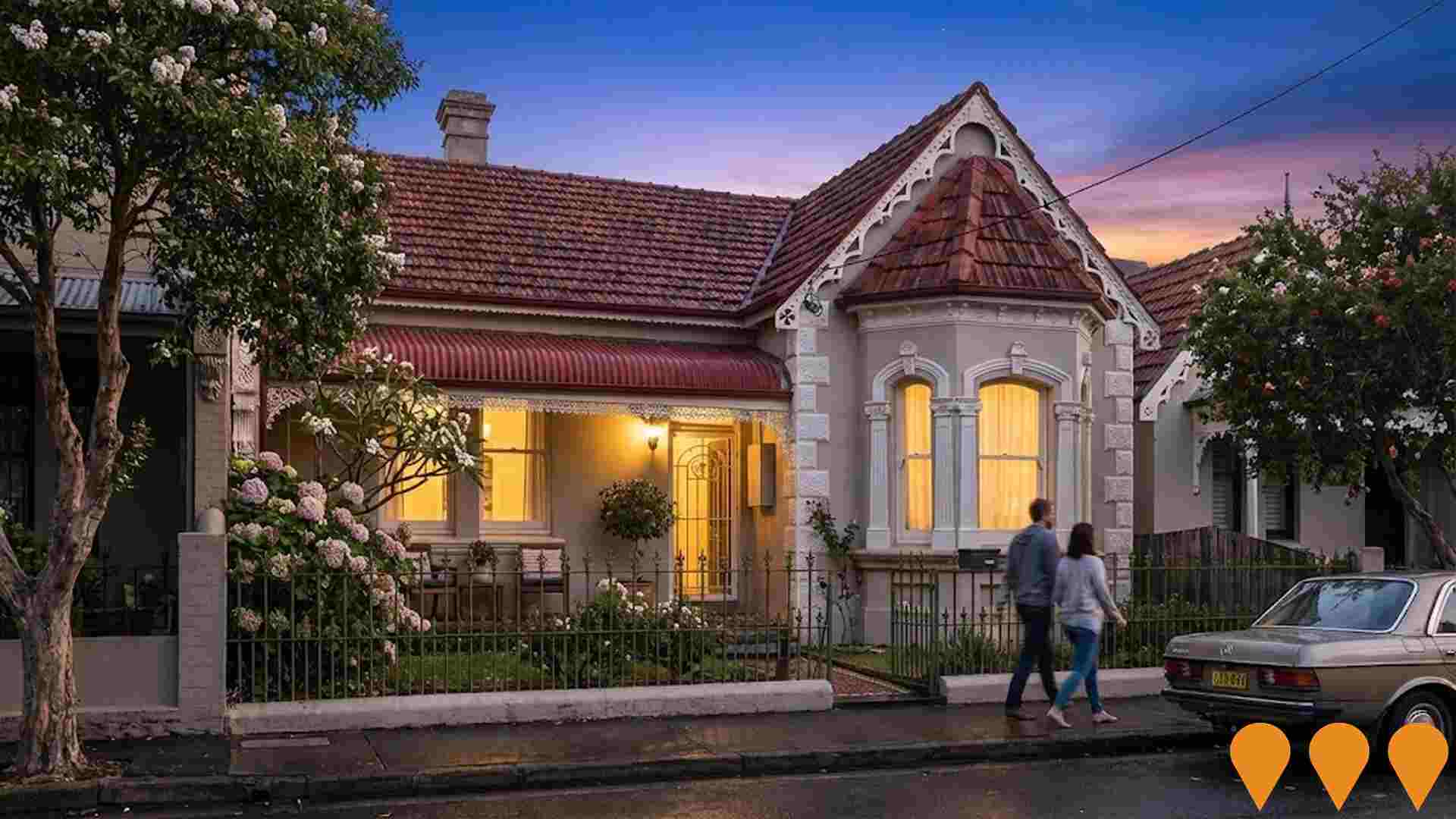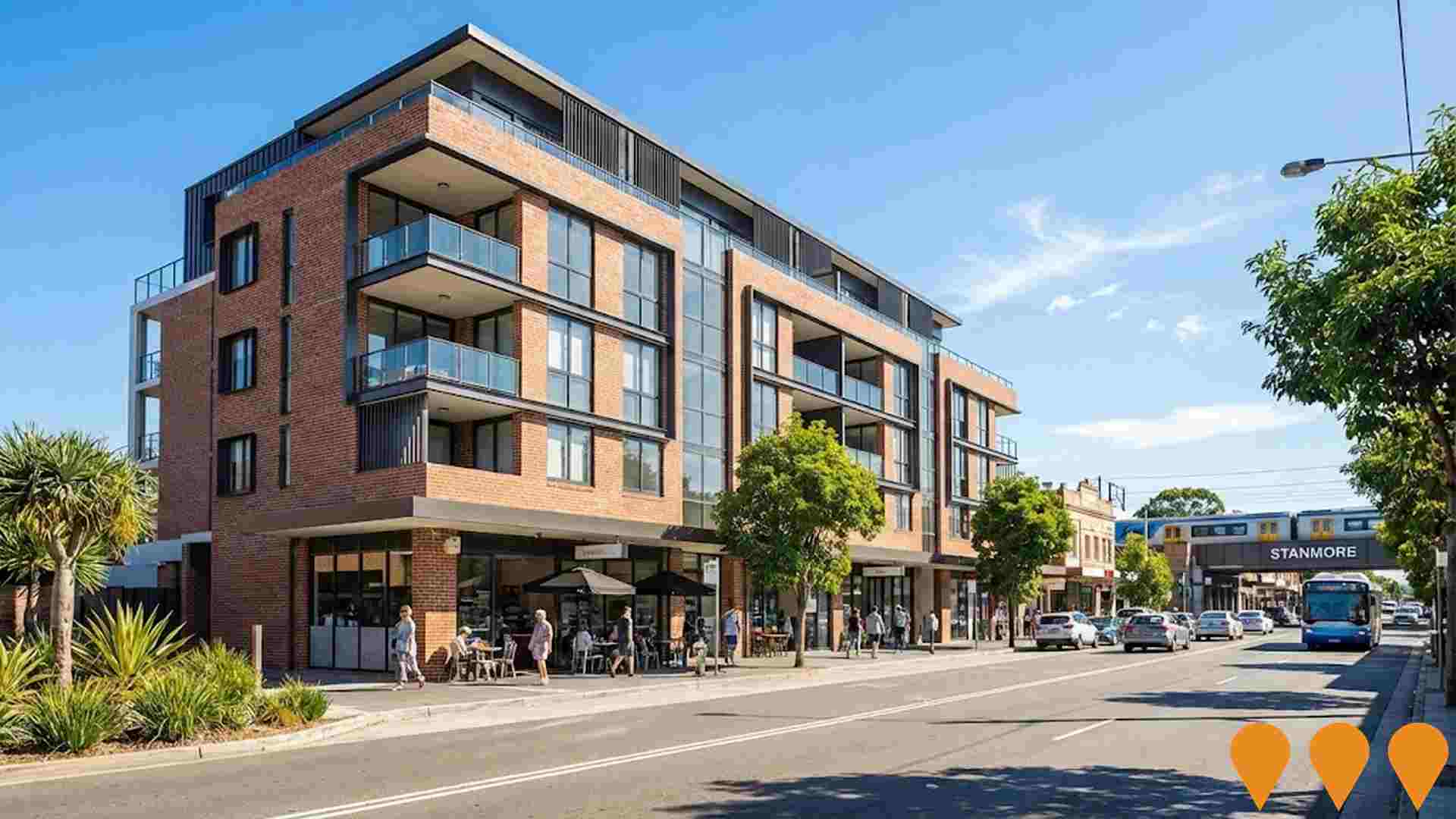Chart Color Schemes
est. as @ -- *
ABS ERP | -- people | --
2021 Census | -- people
Sales Activity
Curious about local property values? Filter the chart to assess the volume and appreciation (including resales) trends and regional comparisons, or scroll to the map below view this information at an individual property level.
Find a Recent Sale
Sales Detail
Population
Petersham - Stanmore is positioned among the lower quartile of areas assessed nationally for population growth based on AreaSearch's assessment of recent, and medium term trends
Petersham-Stanmore's population is around 21,250 as of Nov 2025. This reflects an increase of 1,352 people since the 2021 Census, which reported a population of 19,898 people. The change is inferred from the estimated resident population of 20,986 in June 2024 and an additional 358 validated new addresses since the Census date. This level of population equates to a density ratio of 7,083 persons per square kilometer, placing Petersham-Stanmore in the top 10% of national locations assessed by AreaSearch. The area's 6.8% growth since the 2021 census exceeded the SA3 area (5.8%) and the state, marking it as a growth leader in the region. Population growth was primarily driven by overseas migration contributing approximately 79.5% of overall population gains during recent periods.
AreaSearch is adopting ABS/Geoscience Australia projections for each SA2 area, released in 2024 with 2022 as the base year. For areas not covered, AreaSearch utilises NSW State Government's SA2 level projections, released in 2022 with 2021 as the base year. Growth rates by age group from these aggregations are applied to all areas for years 2032 to 2041. Future population trends indicate an increase just below the median of statistical areas across the nation, with Petersham-Stanmore expected to increase by 1,155 persons to 2041 based on the latest population numbers, recording a gain of 4.2% in total over the 17 years.
Frequently Asked Questions - Population
Development
AreaSearch assessment of residential development drivers sees a low level of activity in Petersham - Stanmore, placing the area among the bottom 25% of areas assessed nationally
Petersham - Stanmore averaged approximately 35 new dwelling approvals annually over recent years. Between financial year 2021 (FY-21) and FY-25175 homes were approved, with an additional 4 approved in FY-26 as of the current date. Despite a decrease in population during this period, housing supply has remained adequate relative to demand, resulting in a balanced market with good buyer choice.
The average expected construction cost value for new dwellings is $338,000. In the current financial year, there have been $69.2 million in commercial approvals, indicating robust local business investment. Compared to Greater Sydney, Petersham - Stanmore has recorded significantly lower building activity, with 56.0% below the regional average per person. This scarcity of new properties typically strengthens demand and prices for existing properties. Similarly, this activity is under the national average, suggesting the area's established nature and potential planning limitations. New development consists of 25.0% standalone homes and 75.0% townhouses or apartments, indicating a trend towards denser development that appeals to downsizers, investors, and entry-level buyers.
Petersham - Stanmore has around 758 people per approval, reflecting its mature and established character. Population forecasts project an increase of 891 residents by 2041. At current development rates, new housing supply should comfortably meet demand, providing good conditions for buyers and potentially supporting growth beyond current population projections.
Frequently Asked Questions - Development
Infrastructure
Petersham - Stanmore has very high levels of nearby infrastructure activity, ranking in the top 20% nationally
Changes to local infrastructure significantly impact an area's performance. AreaSearch has identified 28 projects likely affecting the region. Notable initiatives include Brighton Street developments (29-31), Stanmore North Precinct Planning ('Our Fairer Future Plan'), 'A Fairer Future - Inner West Local Housing Strategy' (35,000 new homes), and Petersham Station's low and mid-rise housing precinct. The following list details projects most relevant to the area.
Professional plan users can use the search below to filter and access additional projects.
INFRASTRUCTURE SEARCH
 Denotes AI-based impression for illustrative purposes only, not to be taken as definitive under any circumstances. Please follow links and conduct other investigations from the project's source for actual imagery. Developers and project owners wishing us to use original imagery please Contact Us and we will do so.
Denotes AI-based impression for illustrative purposes only, not to be taken as definitive under any circumstances. Please follow links and conduct other investigations from the project's source for actual imagery. Developers and project owners wishing us to use original imagery please Contact Us and we will do so.
Frequently Asked Questions - Infrastructure
Erskineville Village
$2.3 billion urban renewal masterplan transforming a 50,000sqm former industrial site into a vibrant mixed-use community. The project includes approximately 1,075-1,300 new homes, primarily Build-to-Rent (BTR) apartments (including affordable housing) and build-to-sell townhouses/apartments, along with 5,000sqm of retail/hospitality and the 7,500sqm McPherson Park. Key elements include the Kooka Walk pedestrian boulevard. Development Application for the main BTR component was approved by the City of Sydney.
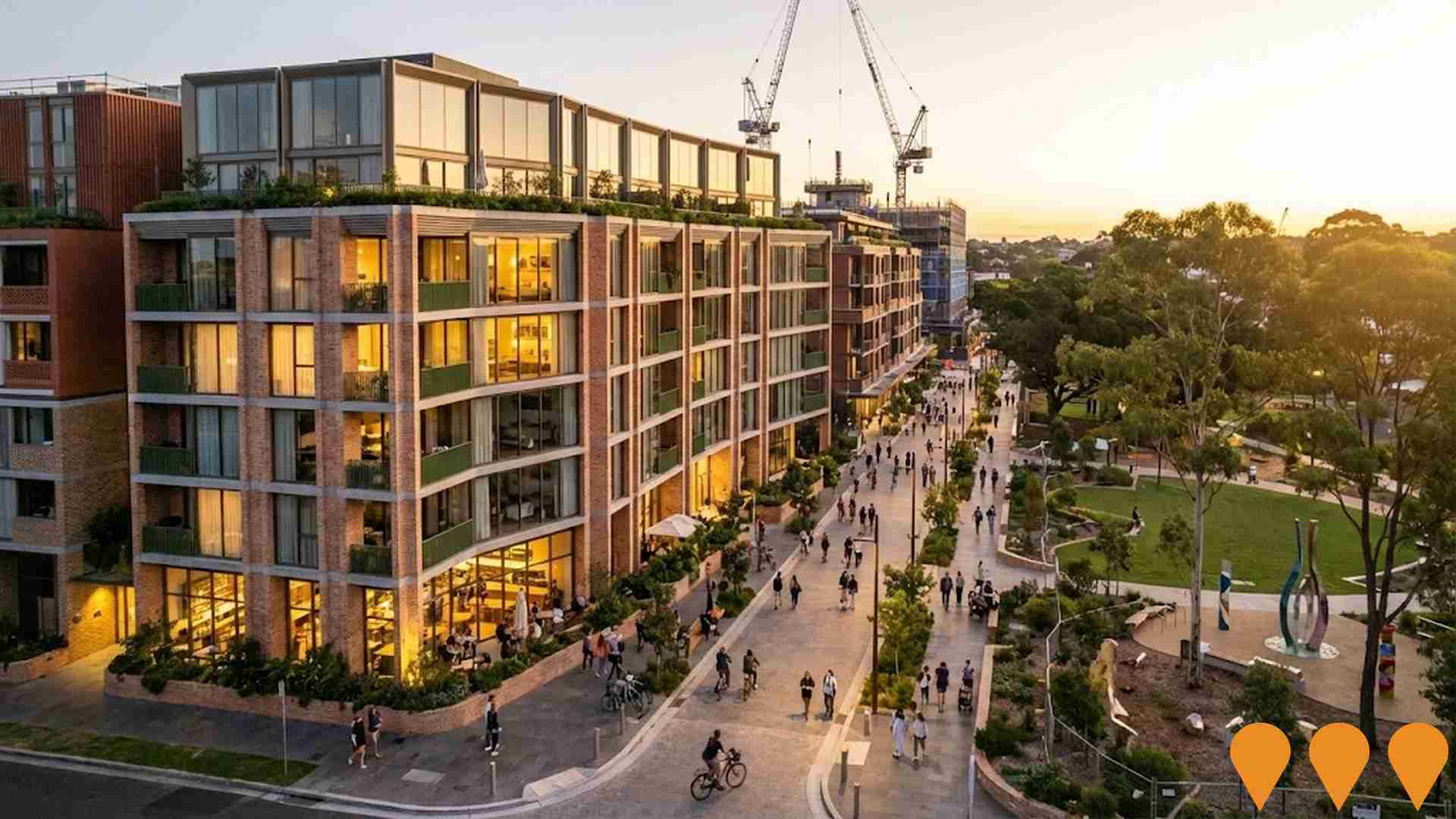
Inner West Housing Investigation Areas
Council-led comprehensive housing strategy (Our Fairer Future Plan) focusing on Housing Investigation Areas around transport nodes including Ashfield, Croydon, Dulwich Hill, Lewisham, Marrickville and others. Includes masterplans for increased density, new parks, plazas, multi-purpose libraries, walking/cycling paths, improved public domain and transport connections. Part of Inner West Council's alternative to NSW Government TOD reforms.

Stanmore North Precinct Planning (Our Fairer Future Plan)
Inner West Council-led planning for the Stanmore North precinct as part of the broader 'Our Fairer Future Plan' to increase housing supply around transport hubs and main streets, in line with the NSW Government's Transport Oriented Development (TOD) program. The plan is an alternative approach developed by Council to allow for increased residential densities and is aiming to deliver approximately 35,000 new homes across the Inner West LGA over 15 years, including new affordable housing, while protecting heritage areas. The draft plan for Housing Investigation Areas, including Stanmore (Stage 2), was considered by Council in May 2025 for public exhibition.
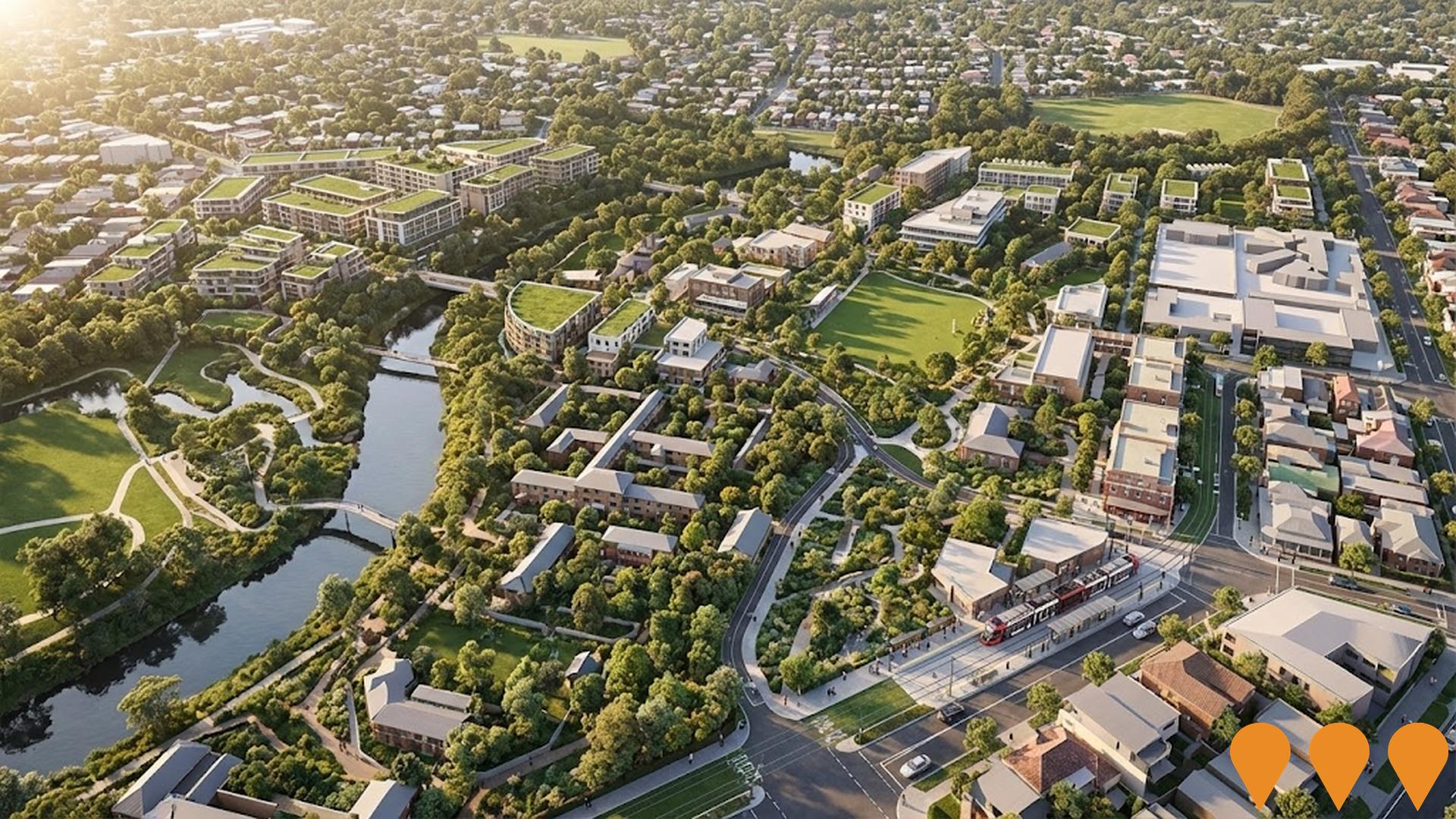
Henson Park Grandstand Redevelopment
Two-stage $20 million redevelopment of the historic King George V Memorial Grandstand at Henson Park, Marrickville. Stage 1 completed September 2025 delivering new female-friendly change rooms, gymnasium, multi-use function room, elevator, accessible amenities and grandstand extension. Stage 2 (under construction, due for completion mid-2026) includes new public toilets, canteen, coaches boxes, media facilities and further upgrades. The venue will become a premier AFLW home ground for Sydney Swans and GWS Giants women's teams while remaining the home of the Newtown Jets rugby league club.

Stanmore Station Precinct TOD (Transport Oriented Development) - Low and Mid-Rise Housing Policy
State-led Transport Oriented Development (TOD) precinct within the Inner West, where the Low and Mid-Rise Housing Policy applies to residential areas within 800m of Stanmore Station to encourage mid-rise apartment development (up to 6-8 storeys). The new planning controls, which commenced on 28 February 2025, aim to deliver more homes, including a mandatory affordable housing contribution for larger developments. This precinct is part of the broader NSW Government TOD Program, but is subject to the Low and Mid-Rise Housing Policy (Stage 2) controls rather than the 400m SEPP controls or the Accelerated Precincts program.
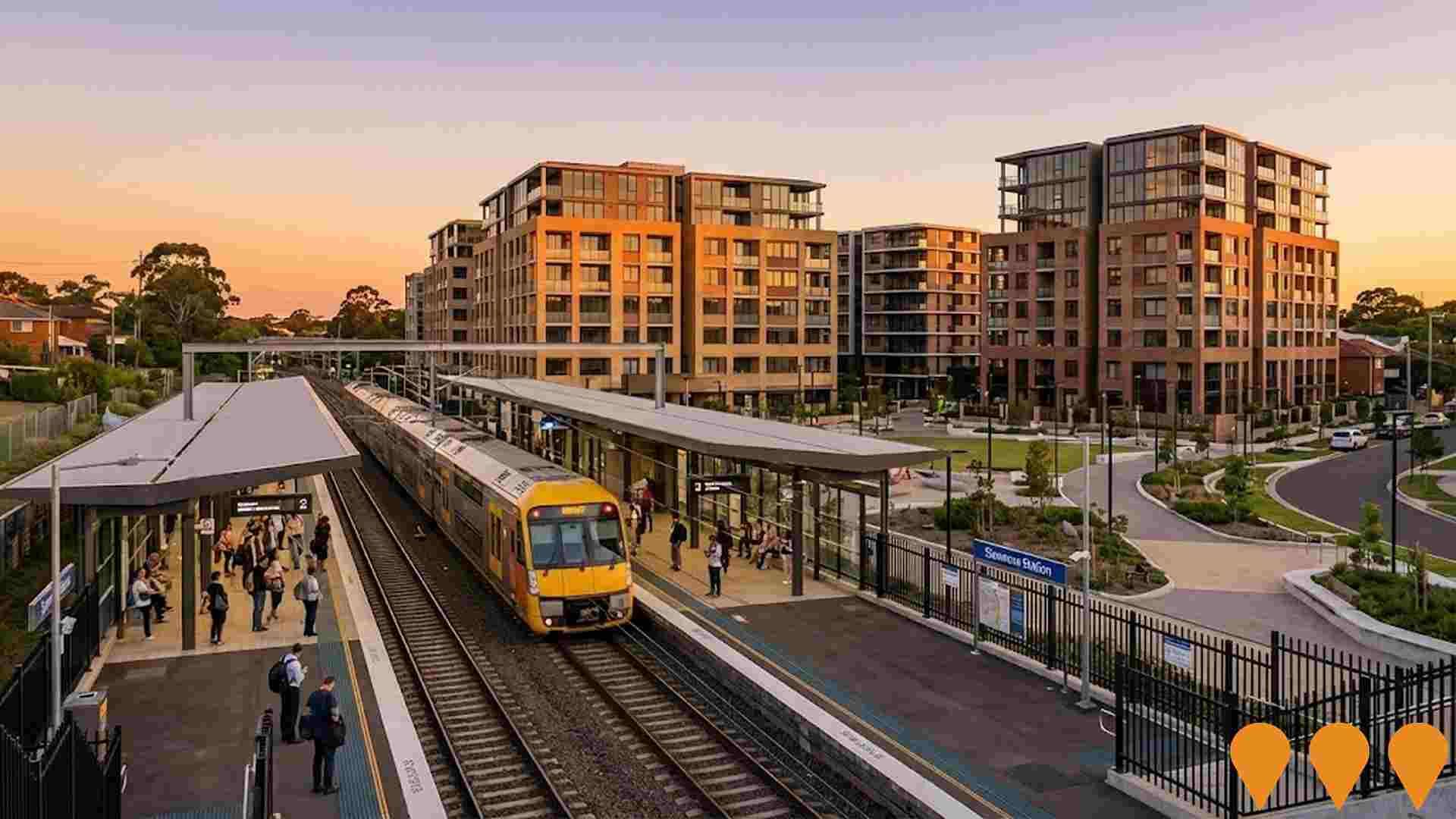
A Fairer Future - Inner West Local Housing Strategy (35,000 New Homes)
Council-led strategic housing program to deliver approximately 35,000 additional homes by 2041 through rezoning, height and density increases around transport hubs and town centres, heritage protection, affordable housing contributions, and supporting infrastructure planning.
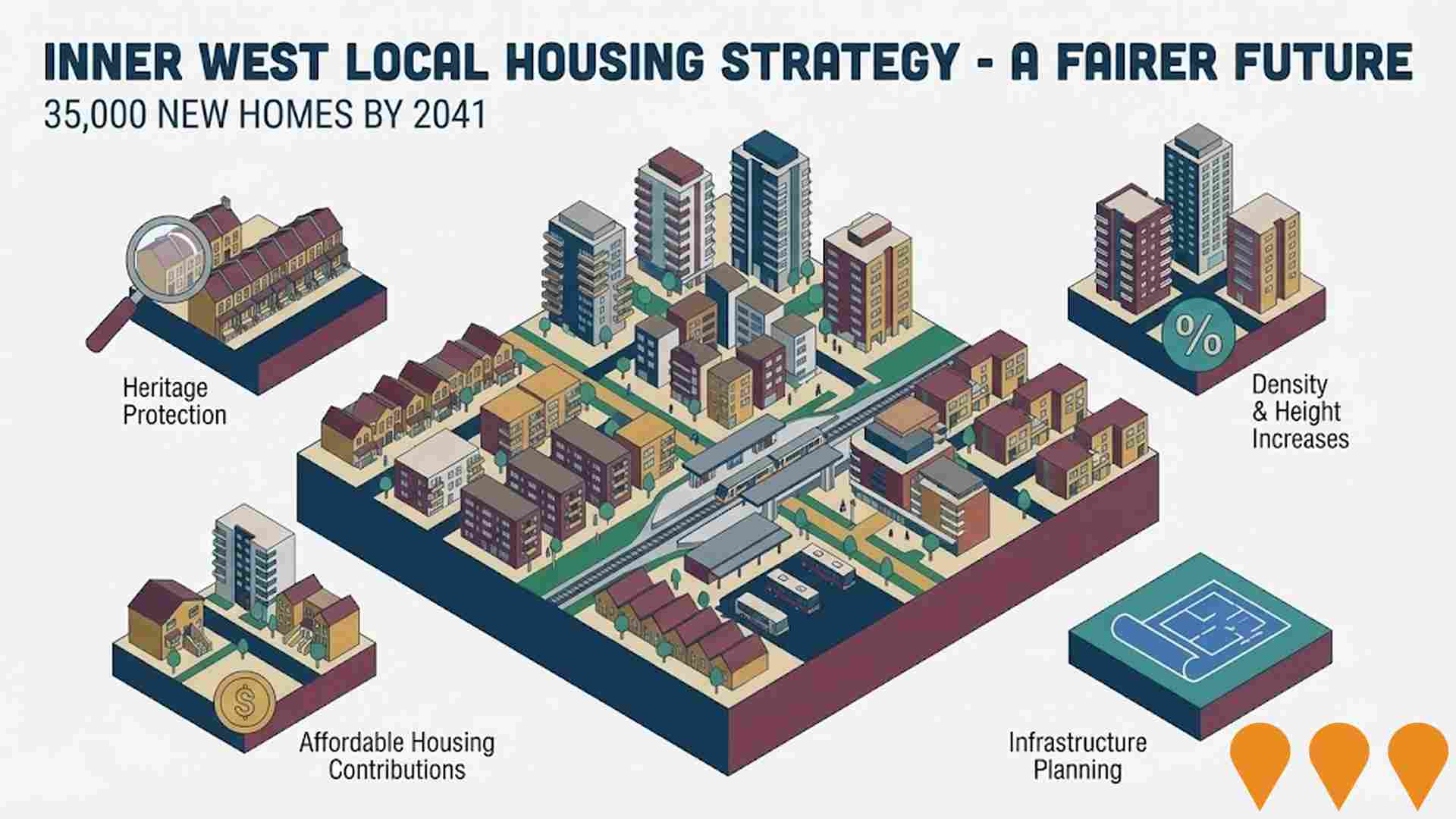
Leichhardt Oval Redevelopment
$40 million redevelopment of historic Leichhardt Oval including new northern grandstand with 3,000 additional seats (increasing capacity from 20,000 to 23,000), renovated western grandstand with NRL-compliant change rooms, female-friendly facilities, upgraded amenities, improved accessibility, and enhanced corporate and media facilities. Project backed by joint funding: $20 million Commonwealth, $10 million NSW Government, $10 million Inner West Council. Expected to host 120+ sporting fixtures annually including NRL, A-League Women's, and community sport. Construction commencing end of 2026 season with completion by 2028.
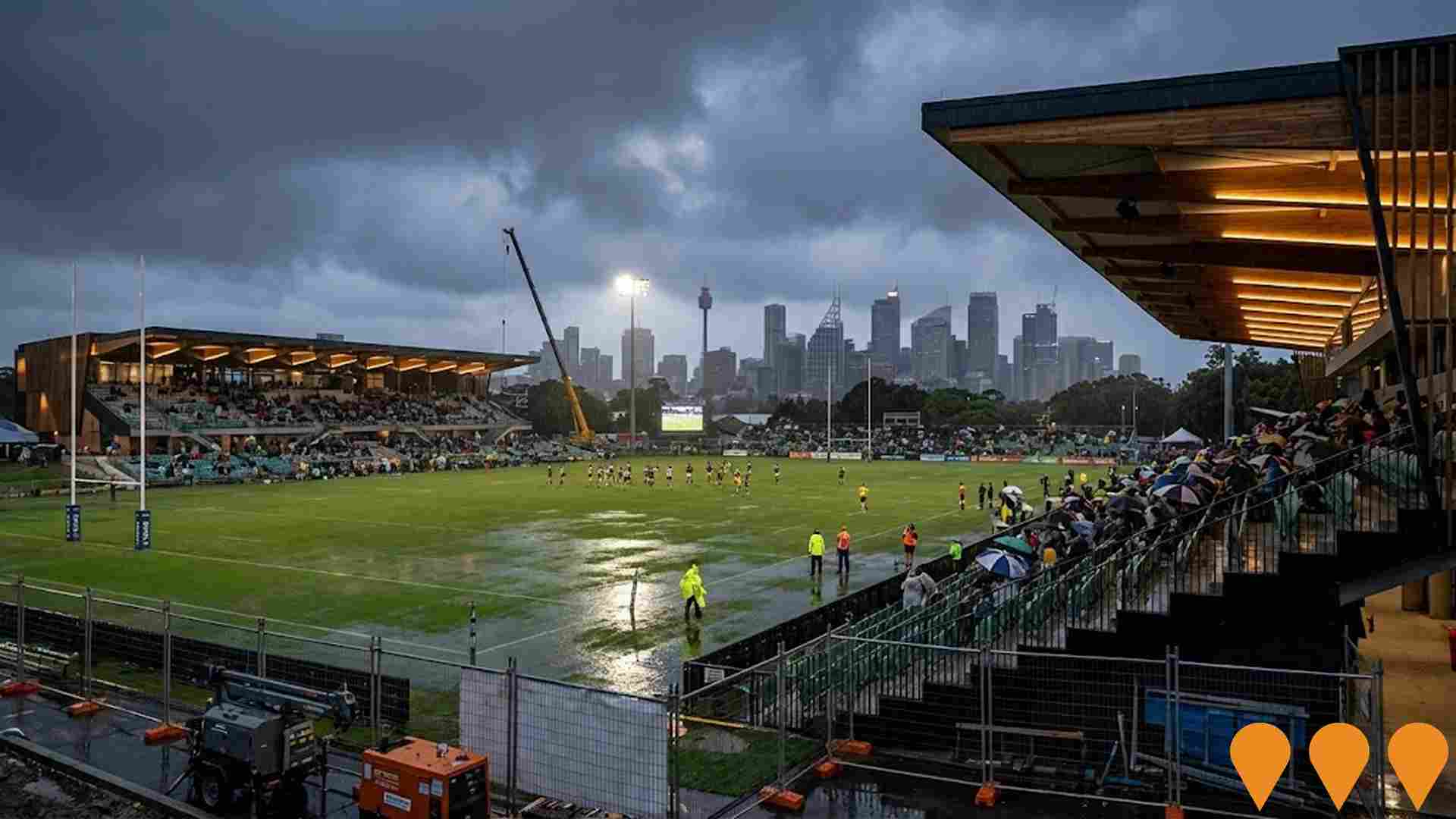
Leichhardt Park Aquatic Centre Renovation
$55 million renovation of Leichhardt Park Aquatic Centre, the biggest upgrade ever undertaken of an Inner West pool. Complete renovation includes new 8-lane 50m Olympic pool (1.1m-1.8m depth), new multiuse 25m pool with moveable floor (2.1m depth), advanced heating/cooling systems, children's play areas, upgraded facilities, and enhanced energy efficiency. Stage 1 commenced April 2025 (children's pool improvements), Stage 2 commencing May 2026 (main pool replacement) with completion September 2027. Serves over 763,000 annual visitors and will secure the facility's future for another 50 years.

Employment
The employment landscape in Petersham - Stanmore shows performance that lags behind national averages across key labour market indicators
Petersham - Stanmore has an educated workforce with a notable presence in the technology sector. The unemployment rate was 5.7% as of June 2024.
Employment growth over the past year was estimated at 0.7%. As of June 2025, 13,289 residents are employed, with an unemployment rate of 6.7%, which is 1.5% higher than Greater Sydney's rate of 5.2%. Workforce participation in Petersham - Stanmore is 71.4%, compared to Greater Sydney's 60.0%. Key industries of employment among residents are professional & technical, health care & social assistance, and education & training.
The area has a strong specialization in professional & technical services, with an employment share 1.5 times the regional level. Conversely, construction shows lower representation at 4.9% compared to the regional average of 8.6%. Employment opportunities locally may be limited as indicated by the count of Census working population versus resident population. Between June 2024 and June 2025, employment levels increased by 0.7%, while labour force increased by 0.7%, keeping the unemployment rate relatively stable at 6.7%. In comparison, Greater Sydney recorded employment growth of 2.6% and labour force growth of 2.9%, with unemployment rising to 5.5%. Jobs and Skills Australia's national employment forecasts from May 2025 project national employment expansion by 6.6% over five years and 13.7% over ten years, with varying growth rates between industry sectors. Applying these projections to Petersham - Stanmore's employment mix suggests local growth of approximately 7.3% over five years and 14.6% over ten years.
Frequently Asked Questions - Employment
Income
The economic profile demonstrates exceptional strength, placing the area among the top 10% nationally based on comprehensive AreaSearch income analysis
AreaSearch's latest postcode level ATO data for financial year 2022 shows that income in Petersham - Stanmore is exceptionally high nationally. The median assessed income is $69,793 while the average income stands at $96,726. This contrasts with Greater Sydney's figures of a median income of $56,994 and an average income of $80,856. Based on Wage Price Index growth of 12.61% since financial year 2022, current estimates would be approximately $78,594 (median) and $108,923 (average) as of September 2025. Census data reveals that household, family and personal incomes all rank highly in Petersham - Stanmore, between the 84th and 93rd percentiles nationally. Income analysis shows that the predominant cohort spans 28.6% of locals (6,077 people) with weekly earnings in the $1,500 - 2,999 category, consistent with broader trends across regional levels showing 30.9% in the same category. A significant 39.6% earn above $3,000 weekly. High housing costs consume 18.9% of income, though strong earnings still place disposable income at the 79th percentile nationally and the area's SEIFA income ranking places it in the 9th decile.
Frequently Asked Questions - Income
Housing
Petersham - Stanmore features a more urban dwelling mix with significant apartment living, with a higher proportion of rental properties than the broader region
The dwelling structure in Petersham-Stanmore, as per the latest Census, consisted of 20.5% houses and 79.5% other dwellings (semi-detached, apartments, 'other' dwellings). This compares to Sydney metropolitan's figures of 29.2% houses and 70.8% other dwellings. Home ownership in Petersham-Stanmore stood at 21.4%, with mortgaged dwellings at 29.5% and rented ones at 49.1%. The median monthly mortgage repayment was $3,000, higher than Sydney metro's average of $2,800. The median weekly rent figure was recorded as $470, compared to Sydney metro's $495. Nationally, Petersham-Stanmore's mortgage repayments were significantly higher than the Australian average of $1,863, while rents were substantially above the national figure of $375.
Frequently Asked Questions - Housing
Household Composition
Petersham - Stanmore features high concentrations of group households and lone person households, with a lower-than-average median household size
Family households account for 56.9% of all households, including 21.9% couples with children, 26.6% couples without children, and 6.9% single parent families. Non-family households constitute the remaining 43.1%, with lone person households at 32.9% and group households comprising 10.3%. The median household size is 2.2 people, which is smaller than the Greater Sydney average of 2.3.
Frequently Asked Questions - Households
Local Schools & Education
Educational achievement in Petersham - Stanmore places it within the top 10% nationally, reflecting strong academic performance and high qualification levels across the community
Educational attainment in Petersham-Stanmore is notably high, with 55.6% of residents aged 15+ holding university qualifications compared to the national average of 30.4% and the NSW average of 32.2%. Bachelor degrees are the most common at 35.5%, followed by postgraduate qualifications (16.1%) and graduate diplomas (4.0%). Vocational pathways account for 20.2% of qualifications, with advanced diplomas making up 9.5% and certificates 10.7%. Educational participation is high, with 28.8% of residents currently enrolled in formal education, including 10.0% in tertiary education, 6.8% in primary education, and 5.8% pursuing secondary education.
There are 8 schools operating within Petersham-Stanmore, educating approximately 3,915 students. The area shows significant socio-educational advantages and academic achievement, with an ICSEA score of 1148. Education provision is balanced, with 5 primary and 3 secondary schools serving distinct age groups. Note: for schools showing 'n/a' in enrolments, please refer to the parent campus.
Frequently Asked Questions - Education
Schools Detail
Nearby Services & Amenities
Transport
Transport servicing is high compared to other areas nationally based on assessment of service frequency, route connectivity and accessibility
Petersham-Stanmore area has 47 active public transport stops offering a mix of train and bus services. These stops are served by 37 different routes, facilitating 9,385 weekly passenger trips in total. The area's transport accessibility is rated excellent, with residents typically located 160 meters from the nearest stop.
On average, there are 1,340 trips daily across all routes, which amounts to approximately 199 weekly trips per individual stop.
Frequently Asked Questions - Transport
Transport Stops Detail
Health
The level of general health in Petersham - Stanmore is notably higher than the national average with both young and old age cohorts seeing low prevalence of common health conditions
Petersham-Stanmore demonstrates above-average health outcomes. Both young and old age cohorts show low prevalence of common health conditions. The rate of private health cover is exceptionally high at approximately 70% of the total population (14,832 people), compared to 64.8% across Greater Sydney and a national average of 55.3%.
The most common medical conditions in the area are mental health issues and asthma, impacting 12.0 and 8.6% of residents respectively. 69.3% of residents declare themselves completely clear of medical ailments, compared to 70.3% across Greater Sydney. The area has 11.7% of residents aged 65 and over (2,484 people), which is lower than the 13.0% in Greater Sydney. Health outcomes among seniors are particularly strong, broadly in line with the general population's health profile.
Frequently Asked Questions - Health
Cultural Diversity
Petersham - Stanmore was found to be more culturally diverse than the vast majority of local markets in Australia, upon assessment of a range of language and cultural background related metrics
Petersham-Stanmore had a higher cultural diversity than most local areas, with 29.3% of its population born overseas and 20.2% speaking a language other than English at home. Christianity was the predominant religion in Petersham-Stanmore, making up 33.5% of people. Judaism, however, was notably overrepresented at 0.6%, compared to the Greater Sydney average of 0.6%.
In terms of ancestry, the top three groups were English (23.0%), Australian (18.5%), and Other (11.7%). There were also notable differences in the representation of certain ethnic groups: Irish (11.2% vs regional 9.7%), French (0.9% vs 0.8%), and Spanish (0.8% vs 0.7%) were overrepresented in Petersham-Stanmore.
Frequently Asked Questions - Diversity
Age
Petersham - Stanmore's population is slightly younger than the national pattern
Petersham - Stanmore's median age is nearly 36 years, close to Greater Sydney's average of 37, which is slightly below Australia's median of 38. Compared to Greater Sydney, Petersham - Stanmore has a higher proportion of residents aged 25-34 (23.2%) but fewer residents aged 5-14 (7.2%). This concentration of 25-34 year-olds is notably above the national average of 14.5%. Between the 2021 Census and now, the proportion of residents aged 15 to 24 has increased from 11.9% to 12.9%, while the proportion of those aged 45 to 54 has decreased from 14.7% to 13.4%. The proportion of residents aged 5 to 14 has also dropped, from 8.4% to 7.2%. By 2041, demographic modeling suggests significant changes in Petersham - Stanmore's age profile. The 65 to 74 cohort is projected to grow by 29%, adding 369 residents and reaching a total of 1,634. Residents aged 65 and above will contribute to 70% of the population growth, highlighting demographic aging trends. Conversely, the populations of those aged 25 to 34 and 0 to 4 are expected to decline.
